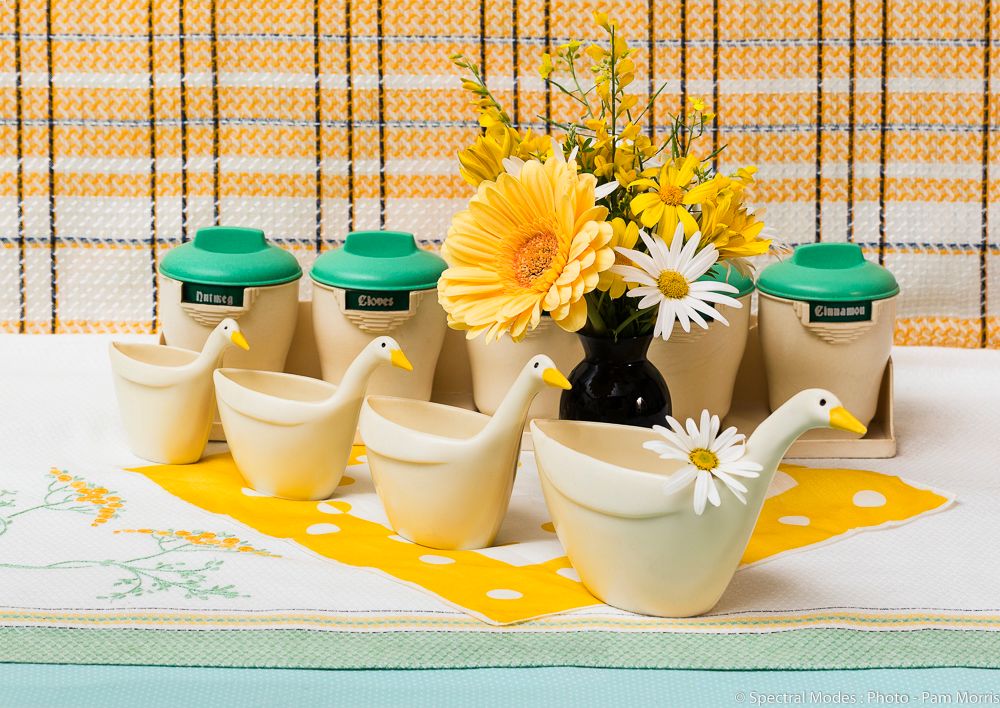Seeing History through Colour with Pam Morris
Recently Julie has been treating you to a wonderful series on the famous brands of makers of pottery and fine china. Also recently we have showcased some photographic images created by Melbourne photographer Pam Morris.
Today you are going to see some excerpts from a fabulous portfolio article produced by Pam Morris which segues beautifully from Julie's china ware to the topic of the importance of colour in our lives.
In Seeing History through Colour Pam Morris showcases a portfolio of images that seeks to illustrate how the different decades of the 20th Century are uniquely characterized by their distinctive colour palettes and decorative styles. The hue and saturation of the specific colours and the decorative shapes of domestic items provide important clues to the feeling and mood of the populace in that era.1
The portfolio commences with 1900-1910 with its Grand Flourishes of Exuberance as illustrated below. Note the dominance of the formal dark greens and browns ... and the regal opulence of dark reds and gilt trims. 1

1900 - 1910 Grand Flourishes of Exuberance
With the dawn of the 20th Century, Queen Victoria’s reign over the British Empire was at the peak of its world colonization. The Victorians overtly demonstrated their wealth and worldliness by embodying it in an eclectic, cluttered, decorative style. Furnishing colours were formal dark greens and browns, punctuated with the rich regal opulence of dark reds and gilt trims. Exotic parlour palms and indoor plants sourced from the far reaching colonies were used to further support their self-aggrandizement. 1
In Pam Morris' article The images investigate how the combination of hue, shape and materials used in these household items characterize each decade such that we can immediately assign a date to an item merely by observing what it is made of and the colours and patterns used in its construction. These attributes in turn tell us something about the attitudes, technology and cultural environment of the times as each era reminisces past eras, and replicates their fashions but rejects outright the fads of the previous decade. The fashion of the day takes what we have historically admired but then makes it ‘new’ again by uniquely combining it with a twist of what the current technology can produce influenced by the latest social ideology.1
I am only going to showcase a selection of the periods showcased in Pam's portfolio article but please do take the time to follow the link at the end of the post to view the complete set of images representing time periods from 1900 to 2000 with Pam's detailed explanation of how influences of the times dictate our preference for houshold objects.

1920 - 1930 - Flappers
Finally women had won the right to vote and the suffragettes discarded the last of the formal constraints of the 19th Century and the flapper era had begun...1
Read the complete description of this image by following the link at the end of the post.

1930 - 1940s Arts and Crafts
Art Deco first arrived in the 1920s but it was the 1930s and 40s where it gained its full recognition, embodying the ideals of a new age of hope and freedom after the ‘war to end all wars’ had ended... 1

1940 - 1950s Sombre Austerity of War
The advent of the Second World War (1939 – 1945) brought with it increased government spending and employment in the military resulting in the end of the Great Depression... 1

1940s - 1950s Homecoming and back to Nature
The end of the Second World War was a time for worldwide rejoicing. Men returned home ready to start again and begin a new life in the homeliness of domestic stability...1

1970 - 1980s Baby Boomer Optimism
As the 1970s drew to a close the rebellious protesters became more conservative and mainstream. However they held onto their ideals, and as parents they encouraged their children to have a voice and be present in their lives... 1

1980 - 1990s Age of Excess
The 80s brought with it all the excesses that had been suppressed in the previous decade. Technology enabled neon dyes, para silk, lycra and polyester... 1
To view all the images created by Pam Morris in her portfolio portraying changing colours of household objects in decades of the C20th, follow the link to Seeing History through Colour.
If you would like to see the two posts we have already produced on works by Pam Morris follow the bookmark links below.


© Thank you to Pam Morris who kindly gave permission for excerpts from the article Seeing History through Colour and a selection of accompanying images to be shown on AnArt4Life.
Credit
1. spectralmodes.com
